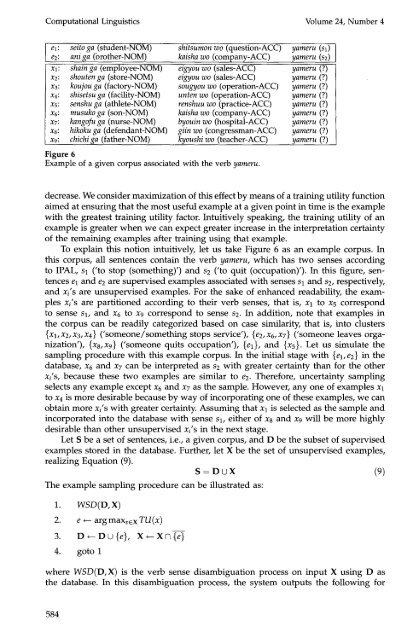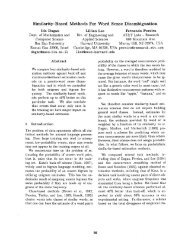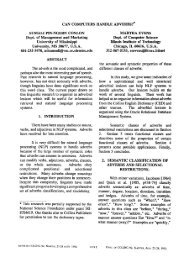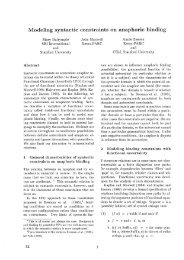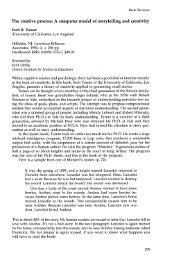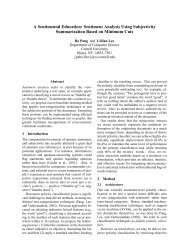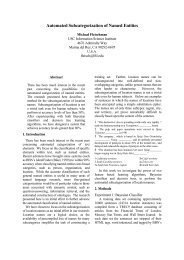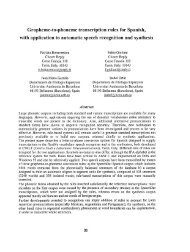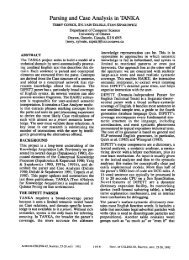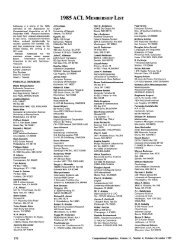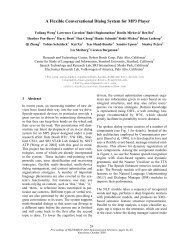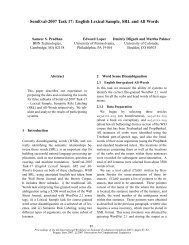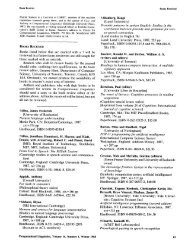Selective Sampling for Example-based Word Sense Disambiguation
Selective Sampling for Example-based Word Sense Disambiguation
Selective Sampling for Example-based Word Sense Disambiguation
You also want an ePaper? Increase the reach of your titles
YUMPU automatically turns print PDFs into web optimized ePapers that Google loves.
Computational Linguistics Volume 24, Number 4<br />
el: seito ga (student-NOM) shitsumon wo (question-ACC) yameru (sl)<br />
e2: ani ga (brother-NOM) kaisha wo (company-ACC) yameru (s2)<br />
Xl: shain ga (employee-NOM) eigyou wo (sales-ACC) yameru (?)<br />
x2: shouten ga (store-NOM) eigyou wo (sales-ACC) yameru (?)<br />
x3: koujou ga (factory-NOM) sougyou wo (operation-ACC) yameru (?)<br />
x4: shisetsu ga (facility-NOM) unten wo (operation-ACC) yameru (?)<br />
xs: senshu ga (athlete-NOM) renshuu wo (pracfice-ACC) yameru (?)<br />
x6: musuko ga (son-NOM) kaisha wo (company-ACC) yameru (?)<br />
x7: kangofu ga (nurse-NOM) byouin wo (hospital-ACC) yameru (?)<br />
x8: hikoku ga (defendant-NOM) giin wo (congressman-ACC) yameru (?)<br />
xg: chichi ga (father-NOM) kyoushi wo (teacher-ACC) yameru (?)<br />
Figure 6<br />
<strong>Example</strong> of a given corpus associated with the verb yameru.<br />
decrease. We consider maximization of this effect by means of a training utility function<br />
aimed at ensuring that the most useful example at a given point in time is the example<br />
with the greatest training utility factor. Intuitively speaking, the training utility of an<br />
example is greater when we can expect greater increase in the interpretation certainty<br />
of the remaining examples after training using that example.<br />
To explain this notion intuitively, let us take Figure 6 as an example corpus. In<br />
this corpus, all sentences contain the verb yameru, which has two senses according<br />
to IPAL, sl ('to stop (something)') and s2 ('to quit (occupation)'). In this figure, sen-<br />
tences el and e2 are supervised examples associated with senses Sl and s2, respectively,<br />
and xi's are unsupervised examples. For the sake of enhanced readability, the exam-<br />
ples xi's are partitioned according to their verb senses, that is, xl to x5 correspond<br />
to sense Sl, and x6 to x9 correspond to sense s2. In addition, note that examples in<br />
the corpus can be readily categorized <strong>based</strong> on case similarity, that is, into clusters<br />
{Xl, X2, X3, X4} ('someone/something stops service'), {Ca, X6, X7} ('someone leaves orga-<br />
nization'), {Xs, X9} ('someone quits occupation'), {el}, and {Xs}. Let us simulate the<br />
sampling procedure with this example corpus. In the initial stage with {el, e2} in the<br />
database, x6 and x7 can be interpreted as s2 with greater certainty than <strong>for</strong> the other<br />
xi's, because these two examples are similar to e2. There<strong>for</strong>e, uncertainty sampling<br />
selects any example except x6 and x7 as the sample. However, any one of examples Xl<br />
to x4 is more desirable because by way of incorporating one of these examples, we can<br />
obtain more xi's with greater certainty. Assuming that Xl is selected as the sample and<br />
incorporated into the database with sense Sl, either of x8 and x9 will be more highly<br />
desirable than other unsupervised xi's in the next stage.<br />
Let S be a set of sentences, i.e., a given corpus, and D be the subset of supervised<br />
examples stored in the database. Further, let X be the set of unsupervised examples,<br />
realizing Equation (9).<br />
S = D u X (9)<br />
The example sampling procedure can be illustrated as:<br />
1. WSD(D, X)<br />
2. e ~ arg maxx~x TU(x)<br />
3. D ~--D U {e}, X ~-- X n {e}<br />
4. goto 1<br />
where WSD(D, X) is the verb sense disambiguation process on input X using D as<br />
the database. In this disambiguation process, the system outputs the following <strong>for</strong><br />
584


